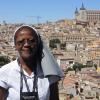For my mission as a young religious sister in the rural part of eastern Nigeria in 1983, I faced many rough roads – some unacceptable, some unbelievable and some with good outcomes. Where do I start!
After my religious profession in 1981, my superiors sent me to the most remote part of Mbaise community in Imo State in Nigeria to start a healthcare clinic. I was a 22-year-old Handmaid of the Holy Child Jesus with a high-school level of education and a two-year apprenticeship in public health from Sierra Leone in West Africa. I commuted from an established convent via motorcycle. On several occasions, the roads were so bad that I fell from the motorcycle into potholes and into stagnant water.
With no money to start this new mission and because the congregation was invited by the bishop of the diocese, I went to him and the parish priest for help. I was told “there is no money,” so I also went to the village chief – and got the same answer. I decided to check with my congregation. Their response was “to manage with donors from the village.”
I started what I called an antenatal and under-five clinic, where pregnant women were cared for throughout their pregnancy and delivery and where children’s developmental milestones were followed until they were five years old. Occasionally, I would host a campaign to weigh children and award any child who reached the correct percentile on growth charts and who had many visits to the clinic with a Teddy bear, clothing or a certificate.
Dealing with the villagers was a very enriching experience – to get pregnant women to seek early obstetrical care was difficult, and luring them to the clinic required some diplomacy. So I made friends with the mothers-in-law and the leaders in the village and the surrounding villages. I also visited homes in the evening, when people came back from their farms or market. This became the number-one key to getting pregnant women to healthcare.
I also took young adults to the Mary League Society where they helped the parish priest by laundering church linen on Saturdays. In a predominately Catholic village, most announcements and events went through the Catholic church and the parish priest. So the Catholic priest and the village chief could work together for the good of the village. By the end of the year I captured and gained the favor of the chief and the leaders, who in appreciation for the work I had done, gave a piece of land at no cost to the sisters to build a health center. With the money I raised from the clinic, I started building a cost-effective health center that is currently the only one in that village.
With all these said, the pertinent question now is, “So what?” Religious sisters influence rural areas in many ways. But this humble encounter gradually spurred my quest for more education, which has equipped me to work on health challenges in countries with poor health access and education.
[Christine Okpomeshine, a Handmaid of the Holy Child Jesus (HHCJ), is currently an associate professor of nursing at New Jersey City University. She has a Ph.D. in public health with concentration in community prevention and education and presented in July at the 25th international Nursing Research Congress in Hong Kong.]
